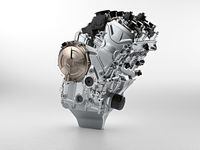When you look at the cylinder heads of late-model bike engines, you see just a black plastic gizmo atop each of the engine’s deep spark-plug wells. Colored wires emerge, running to an ignition box. Because most engines now have four valves per cylinder, a single spark plug is placed at the center of each combustion chamber, minimizing the distance flame must travel from initiating spark to cylinder wall. Emerging from each such gizmo are ordinary low-voltage insulated wires, not the familiar 7mm black rubber-insulated ignition wire of the past. Those gizmos are compact “stick” coils, one for each spark plug.
And where early Harley-Davidson Sportsters, original two-stroke Kawasaki H1s, and auto engines had distributors, today there are none. Why the change, and how does this technology work?
In days of yore, when according to some, men were men, a set of breaker points—really just a cam-operated mechanical switch—closed, allowing battery current to flow into the primary winding of a single ignition coil. That current set up a magnetic field storing significant energy around the winding. When after some dwell time, the breaker cam pushed the points open, current quickly died away in the coil primary, allowing that magnetic field to collapse. As it did so, it induced a much higher-voltage, lower-current pulse into a secondary coil winding having many times more turns than the primary coil. As that voltage rose, it traveled through the familiar black rubber-insulated plug wire to a spark plug. The rising voltage produced a powerful electric field across the spark-plug electrodes, accelerating any stray electrons there to high velocity. Those fast-moving electrons crashed into other atoms in the plug’s gap, knocking more electrons loose from them, which were in turn accelerated by the electric field, producing an electron cascade—a spark—across the gap.
RELATED: Technology Validated In The Showroom, Not On The Racetrack
But there were problems. Those black rubber-insulated plug wires acted as radio frequency (RF) antennas, broadcasting annoying radio and TV interference. Inside the distributor, the rotating arm whose job it was to conduct spark current to one after another spark-plug lead, which we used to see sprouting from the distributor cap, was carrying high voltage. Any dust, moisture, or acid surface layer inside that cap could and ruthlessly would short-circuit the spark. In the case of the 1969 Kawasaki H1, with its go-for-broke advanced CDI, the presence of intense electrical fields produced corona loss. Dealers then received a snowfall of memos and updates on how to make customer engines run as smoothly as those in the R&D department. That's life in the technological fast lane.
In the magnetos and distributors of aircraft piston engines of the 1940s, operation at high altitude intensified this problem because it’s easier for unwanted sparks to jump through thinner air. Therefore magnetos and the heavily constructed wire harnesses that carried their spark voltage to the plugs had to be pressurized to prevent internal arcing, misfire, and other ills. Sitting on its own pad on each engine’s accessory drive case was the gear-driven magneto pressurization pump. Part of the reason for the wire harness’ weight was that every plug wire had to be shielded with metal, and aircraft engine spark plugs themselves were made with an external metal shield surrounding its insulator—all tediously assembled by screw threads—to prevent the 144 spark plugs and plug wires on every four-engine airplane from making radio communication impossible (four engines times 18 cylinders per engine times two spark plugs per cylinder head equals 144).
It was easier on highways. By giving plug wires high resistance, substituting a carbon core for the traditional metal wire, only the initial brief high-voltage discharge could take place. In some cases, the resistance was moved into the spark plug itself as either a resistor or a gap. But still there remained the problem of plug wires frying against hot engine parts. Plus rubber and heat never get along, which is why tire performance “drops” in the heat of MotoGP competition. Looking under the hood at a running engine after dark could reveal ghostly corona or even outright sparking, making a new set of wires and plug caps necessary. The auto tune-ups that used to interrupt the lives of motorists every thousand miles or so were mainly to keep this not-so-hot technology at its best operating point.
So when I brought home my third large aircraft piston engine made in maybe 1953 or so, I wasn’t surprised to find 1) four big, low-tension magnetos and 2) ignition coils mounted in pairs directly on each of the engine’s 28-cylinder heads. Before that invention, Strategic Air Command planners had been tearing their hair and considering crazy stuff like filling the mags with sulfur hexafluoride gas, which strongly resists unwanted sparking and corona. They wanted to operate their B-36 bomber with its six 28-cylinder piston engines at 40,000 feet and were going crazy trying to get mechanics to remember all the finicky pressurization pump connections, check valves, and tests before every hoped-to-be 10,000-mile test flight.
So in their desperation, they became brilliant: They simplified and added lightness. Away went troublesome high voltage in magnetos, distributors, and plug wire harnesses. No more heavy metal-sheathed HV wiring. No magneto pressurization pump. Just the simplicity of one coil per spark plug, working through a very short lead. And no more trying to transform regular-guy line mechanics into check-list-waving engineers.
Something similar has now happened in the auto industry: the stick coil. I suspect that some enterprising junior engineer looked at how deeply buried are the central spark plugs in modern four-valve engines with a single cover over both cams. It’s a long way down from the cam cover surface to the plug itself. What if compact ignition coils could occupy some of that space? Surrounded by metal on all sides, they would need zero RF shielding. And the wires supplying power to them could be cheap, ordinary low-voltage stuff that generated no RF interference. No more tired plug wires to replace.
And so it was done. As you’d expect when a new technology replaces an older one, there have been some early failures and complaints, but in general I like the new coils. And with so many electronic systems appearing on cars and bikes, RF interference can be a real bear. Just yesterday I was reading about an auto model that saves its owner’s delicate wrists by featuring a power gas cap. It wouldn’t do to have RF interference constantly screwing and unscrewing your gas cap.













/cloudfront-us-east-1.images.arcpublishing.com/octane/AUE3NFVRRZDSBIDVUGIYIDQNUI.jpg)
/cloudfront-us-east-1.images.arcpublishing.com/octane/LYR62CH2WNBMHJJVXVATZHOUE4.jpg)
/cloudfront-us-east-1.images.arcpublishing.com/octane/RBCTRGBQYBDK7A6XPG3HKPS7ZQ.jpg)
/cloudfront-us-east-1.images.arcpublishing.com/octane/MQXQRYMZVBCWJIRYP3HEN3SHVE.jpg)
/cloudfront-us-east-1.images.arcpublishing.com/octane/TSPODNNEWRDSVJGUCNQTDG4ADI.jpg)
/cloudfront-us-east-1.images.arcpublishing.com/octane/X5TB7BDV4BA2RPSY54ZGK27RP4.jpg)
/cloudfront-us-east-1.images.arcpublishing.com/octane/REUHOJXRDBGZ5IHBYZCCBCISPA.jpg)
/cloudfront-us-east-1.images.arcpublishing.com/octane/52LGJTCKBFEHDF7S7H4CVUIMGM.jpg)
/cloudfront-us-east-1.images.arcpublishing.com/octane/YMWAIPIPSJAOXOU3QMJMGH37OM.jpg)


/cloudfront-us-east-1.images.arcpublishing.com/octane/EJ6KZRGAYBCVXNL2PJXL37UVWQ.jpg)
/cloudfront-us-east-1.images.arcpublishing.com/octane/AAN4TI76M5H5JMUVEIGASWXBDU.jpg)
/cloudfront-us-east-1.images.arcpublishing.com/octane/P3RXD2UCPFF37CMB7CHPVKXORY.jpg)
/cloudfront-us-east-1.images.arcpublishing.com/octane/VZEG2EJI2RDFZNHLRZMU56MD3Q.jpg)
/cloudfront-us-east-1.images.arcpublishing.com/octane/GVJQO5FFOFBWNGODOBRB4FBAW4.jpg)
/cloudfront-us-east-1.images.arcpublishing.com/octane/BIVAK2SFIBDJJM25E7I5VU2FJE.jpg)
/cloudfront-us-east-1.images.arcpublishing.com/octane/CH5VX52UG5CFHOVH5A6UYEFWWA.jpg)
/cloudfront-us-east-1.images.arcpublishing.com/octane/ZVGJNGZRU5C33N7KN23BBFKSC4.jpg)


/cloudfront-us-east-1.images.arcpublishing.com/octane/CZ5OM3E43ZEXJHY7LCYXCHLIKI.jpg)
/cloudfront-us-east-1.images.arcpublishing.com/octane/DF5T4K5KPZFJXFCTGPYR77PKJM.jpg)
/cloudfront-us-east-1.images.arcpublishing.com/octane/RMCT2KVQBJHBZMRTSLOVPMOILU.jpg)